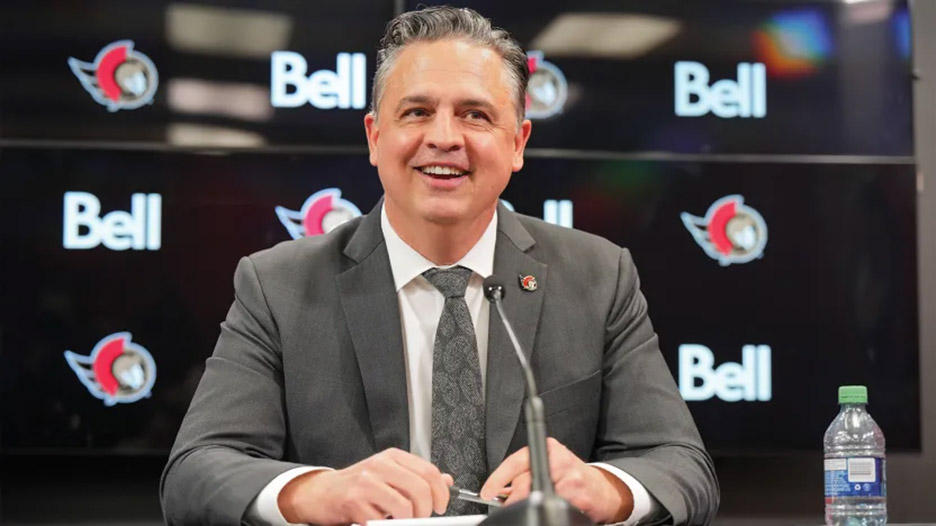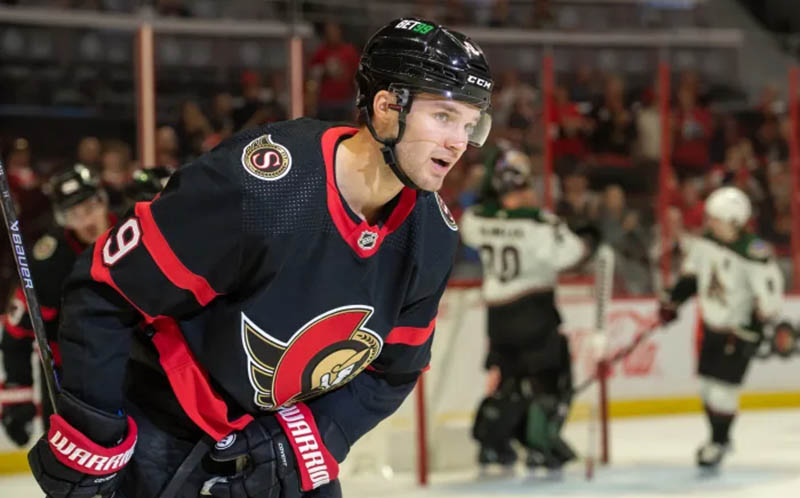
From Strategy to Execution: How Travis Green’s Tactics Are Shaping Ottawa’s Season
Travis Green’s appointment as head coach of the Ottawa Senators in May 2024 marked a pivotal moment for the franchise. Tasked with ending a seven-year playoff drought, Green’s influence on the team’s defensive adjustments, offensive strategies, and special teams performance has been profound.
Defensive Adjustments Under Green
Travis Green’s tenure with the Ottawa Senators has been marked by a significant transformation in the team’s defensive approach. Recognizing that previous seasons were plagued by defensive lapses, Green prioritized restructuring the defensive framework to reduce goals against and enhance overall team stability.
Under Green’s guidance, the Senators have adopted a more disciplined defensive structure. This shift is evident in their improved goals-against metrics, with the team allowing fewer high-danger scoring opportunities compared to previous seasons. Green’s insistence on accountability and positioning has been instrumental in this transformation.
A key component of the Senators’ defensive resurgence has been the strategic deployment of defensive pairings. The duo of Thomas Chabot and Nick Jensen, for instance, has exemplified synergy and effectiveness, leading to a positive shot share and improved defensive zone exits. Green’s tactical acumen in pairing these defensemen has fortified the team’s back end.
Offensive Strategies Implemented
While defense has been a focal point, Green has not neglected the offensive aspect of the game. His strategies have aimed to diversify the Senators’ offensive arsenal, making them less predictable and more dynamic in the attacking zone.
Historically, the Senators relied heavily on rush plays for scoring opportunities. Green identified this predictability and introduced systems to generate offense from sustained pressure and forechecking. This adaptation has led to a more balanced attack, reducing the team’s reliance on fast breaks and enhancing puck possession in the offensive zone.
Green’s influence is evident in the development of the team’s forwards. Players like Tim Stützle and Drake Batherson have thrived under his system, showcasing improved point production and two-way play. Green’s emphasis on responsibility at both ends of the ice has cultivated a more cohesive and effective offensive unit.
Special Teams Performance
Special teams play is often a differentiator in tight games, and under Green, the Senators have seen notable changes in this area. Adjustments to both the power play and penalty kill units have been integral to the team’s competitiveness.
Green’s restructuring of the power play has led to increased movement and unpredictability. By encouraging players to rotate positions and create multiple shooting options, the Senators have become more challenging to defend against with the man advantage. This tactical shift has resulted in a higher power play conversion rate compared to previous seasons.
On the penalty kill, Green has implemented an aggressive approach, pressuring opponents higher up the ice to disrupt their setups. This tactic has led to more turnovers and shorthanded opportunities, reflecting a proactive rather than reactive penalty-killing philosophy.
Inconsistencies in Execution
Despite the positive changes, the Senators have faced challenges with inconsistent execution of Green’s systems. These inconsistencies have sometimes led to lapses in performance and missed opportunities.
At the outset of the season, the team grappled with adapting to new systems, resulting in a sub-.500 record. The learning curve associated with Green’s tactics required time, and early miscommunications were evident in both defensive coverage and offensive coordination.
Recognizing these issues, Green made necessary adjustments, including altering practice routines and simplifying certain aspects of the game plan. These mid-season tweaks have contributed to a more consistent execution in recent games, as players have grown more comfortable within the system.
Lineup Experiments
Green’s tenure has been marked by a willingness to experiment with line combinations and defensive pairings to find optimal chemistry and performance.
To maximize offensive output, Green has shuffled forward lines, pairing veterans with younger players to balance experience and energy. These experiments have led to the discovery of effective combinations that have bolstered the team’s scoring depth.
In response to injuries and performance fluctuations, Green has adjusted defensive pairings, seeking the right balance between defensive reliability and offensive support from the blue line. This adaptability has been crucial in maintaining team performance amidst challenges.
Player Development Focus
A cornerstone of Green’s coaching philosophy is the development of players, both veterans and emerging talents. His approach has fostered growth and confidence across the roster.
Green has placed significant emphasis on mentoring young players, providing them with structured opportunities to develop their skills and grow into impactful NHL contributors. His focus on fostering a competitive yet supportive environment has been evident in the development of players such as Ridly Greig and Shane Pinto.
Both have shown notable improvements in their two-way game, benefiting from Green’s emphasis on defensive responsibility and offensive efficiency.
Tim Stützle, a key offensive weapon for Ottawa, has also thrived under Green’s tutelage. Stützle’s ability to read the game, control possession, and contribute in all three zones has been further refined under Green’s coaching approach. The German forward has seen a rise in his playmaking numbers, demonstrating increased confidence and better decision-making with the puck.
Additionally, Green has worked closely with defensemen such as Jake Sanderson, ensuring that young blueliners develop both defensively and in transition. Sanderson’s ability to break out of the defensive zone efficiently has improved under Green’s system, making him a crucial part of the team’s puck-moving strategy.
Special Teams Adjustments and Results
One of the most evident tactical shifts under Green has been his focus on making the power play more dynamic. By encouraging more player rotation and movement away from static positioning, the Senators have become less predictable when operating with the man advantage. Players like Claude Giroux and Brady Tkachuk have been given more flexibility in their positioning, allowing them to exploit gaps in the opposition’s penalty kill.
With these adjustments, Ottawa has seen an increase in its power-play success rate compared to last season. The improved puck circulation and a stronger net-front presence have contributed to a more potent attack, particularly in crucial game situations.
On the penalty kill, Green has implemented a more aggressive approach that disrupts opposing power plays before they can fully establish their setups. The Senators’ PK unit now applies early pressure, forcing turnovers in the neutral zone and creating shorthanded scoring chances.
This aggressive penalty-killing approach has led to a noticeable drop in the number of goals conceded while shorthanded, further cementing the team’s defensive improvements.
Green’s Tactical Decisions and Playoff Aspirations
Travis Green’s impact on the Senators extends beyond just structural changes—his in-game adjustments and tactical decisions have played a pivotal role in shaping the team’s identity. He has emphasized a more balanced approach between offense and defense, ensuring that Ottawa does not become overly reliant on one aspect of their game.
Green has also shown a willingness to adapt his game plan based on matchups, making key lineup changes and strategic tweaks to counter specific opponents. This adaptability has kept Ottawa competitive in tightly contested games and has allowed them to maximize their strengths against different styles of play.
As the Senators continue their push for a playoff spot, Green’s tactical influence will be a defining factor in determining whether they can break their playoff drought. While the team has shown significant improvement in key areas, consistency remains a challenge, and maintaining momentum throughout the second half of the season will be critical.
Several Ontario betting sites continue to track Ottawa’s form, with Green’s tactical decisions playing a key role in determining their fate. If the Senators can maintain their upward trajectory and sustain their defensive and special teams improvements, they could emerge as a legitimate playoff contender.
The Road Ahead for Ottawa
Travis Green’s first season at the helm of the Senators has been one of evolution and adaptation. His defensive restructuring, offensive refinements, and special teams innovations have all contributed to a more competitive and structured team. While inconsistencies remain, the Senators’ potential under Green is evident, and if they can fine-tune their execution, they could position themselves for a return to playoff hockey.
As Green continues to instill his philosophy and the players grow more comfortable within his system, Ottawa’s trajectory appears to be trending in the right direction. The final stretch of the season will be a true test of their resilience, and whether Green’s tactics can translate into a successful playoff push remains to be seen. However, one thing is certain—his impact on the Senators is already shaping the future of the franchise.








